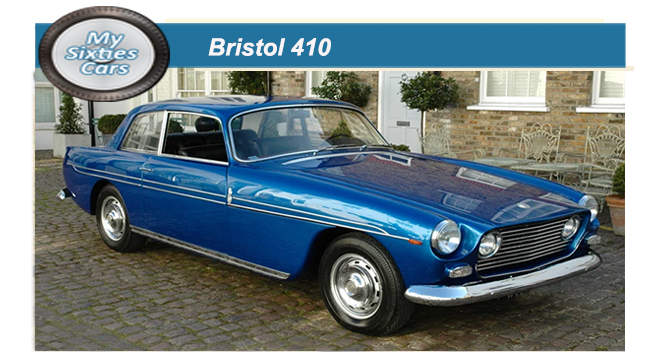
When Bristol announced the launch of the 410 in 1968, the first question that most of the motoring media could come up with was " what else could be done to improve the 400 series?"
The answer was that Bristol's design and engineering department had combined to the styling enhancements of the 408 and the mechanical advancements of the 409 to produce a swift, smooth-riding and manoeuvrable car with predictable handling.
B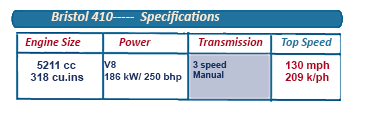 y introducing the Chrysler V8 engine in the 407 in 1961, Bristol had regained the performance edge that they had built up with their six-cylinder 2-litre units almost overnight.
y introducing the Chrysler V8 engine in the 407 in 1961, Bristol had regained the performance edge that they had built up with their six-cylinder 2-litre units almost overnight.
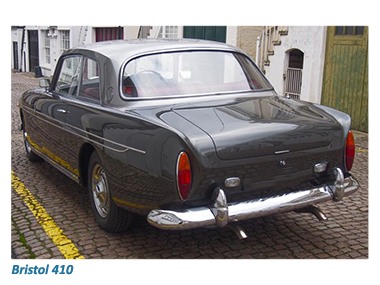 By the time of the 410, the company had refined the 400 V8 engined series into a more than capable vehicle that would bring 'pride of ownership that justifies the considerable price' to those who had the financial ability and imagination to become a Bristol owner.
By the time of the 410, the company had refined the 400 V8 engined series into a more than capable vehicle that would bring 'pride of ownership that justifies the considerable price' to those who had the financial ability and imagination to become a Bristol owner.
Chrysler's all-iron overhead-valve engine was proving a reliable servant. Seamless power delivery and effortless high-speed cruising from the 521 I cc V8 perfectly matched the Bristol's upmarket appeal and was noted as much for its smoothness as for its remarkable lack of noise.
The reason was that engines produced by Chrysler according to Bristol specifications came with a high-lift camshaft and mechanical rather than hydraulic tappets.
Capable of generating 250bhp, it took the 410 just under 9 seconds to pass 60mph (96km/h), the quarter-mile mark breached in a little over 16 seconds.
For the 410 Bristol the gearbox was mounted as a single unit with the engine. To improve weight distribution, the new powertrain was positioned to the back of the chassis.
![]()
Another first on the 410 was that the gears could be held manually up to the red line if ordered, although such driving made little difference to the overall performance figures when using full automatic selection.
To protect against the worst of the English weather, the 410’s frame now came fully undersealed.
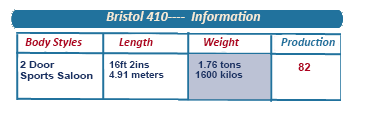
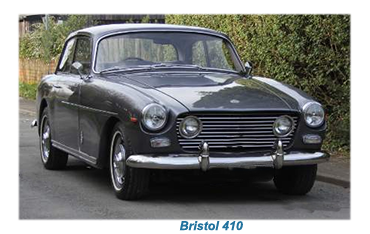 Broader but smaller diameter tyres, coupled with the 410's proper weight distribution, had reduced theV8 series' tendency to oversteer, making for a well-balanced car capable of achieving rapid cross-country progress.
Broader but smaller diameter tyres, coupled with the 410's proper weight distribution, had reduced theV8 series' tendency to oversteer, making for a well-balanced car capable of achieving rapid cross-country progress.
Power steering, once a luxury, was now the norm for cars of the 410's calibre.
The ZF system, designed in conjunction with Bristol, suffered no loss to feel and controllability once on the move and, on a car that was over sixteen feet (4,915mm) long, its fitment made parking much more comfortable.
Once again, it was the front end that was amended, with more fluidity of design.
The flat panel that housed the lighting, that had been the subject of criticism on the 409, gave way to a tidier profiled design, sculpture around the 7in (175mm) headlamps.
![]()
Auxiliary driving lamps were still recessed into the grille.
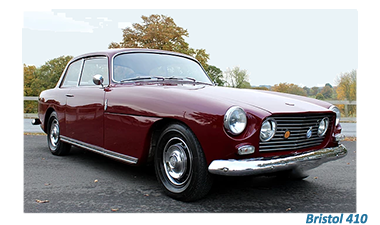 Up front, occupants could fully recline their armchair-like seats; the driver's adjustable for height as well as fore and aft movement "to match the stature of the individual passenger” according to Bristol advertising materials of the time.
Up front, occupants could fully recline their armchair-like seats; the driver's adjustable for height as well as fore and aft movement "to match the stature of the individual passenger” according to Bristol advertising materials of the time.
Back seat passengers were not poorly served either. With generous head and leg room, there was plenty of space for the passengers to stretch out.
A fold-down central armrest complemented those at either side of the cabin, behind which were large storage bins for touring essentials.






